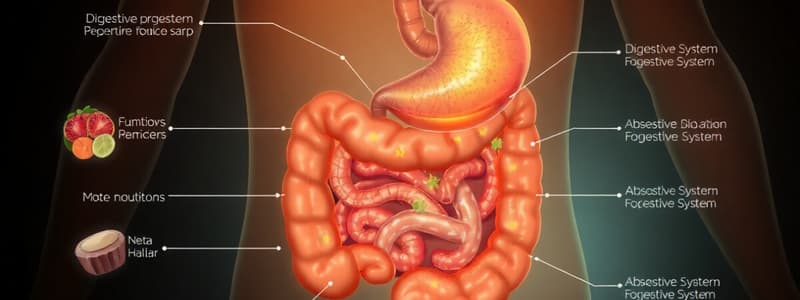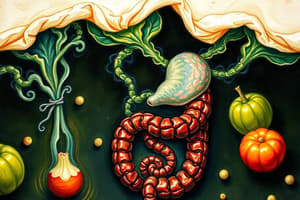Podcast
Questions and Answers
Which of the following is a function of the digestive system?
Which of the following is a function of the digestive system?
- Excretion (correct)
- Circulation
- Ingestion (correct)
- Respiration
What enzyme in saliva begins the digestion of carbohydrates?
What enzyme in saliva begins the digestion of carbohydrates?
Salivary amylase
The esophagus transports food from the stomach to the mouth.
The esophagus transports food from the stomach to the mouth.
False (B)
The _____ produces bile which is essential for the digestion and absorption of fats.
The _____ produces bile which is essential for the digestion and absorption of fats.
What is the role of villi and microvilli in the small intestine?
What is the role of villi and microvilli in the small intestine?
Which of the following structures prevents backflow of stomach contents into the esophagus?
Which of the following structures prevents backflow of stomach contents into the esophagus?
The large intestine primarily absorbs nutrients.
The large intestine primarily absorbs nutrients.
What are the three segments of the small intestine?
What are the three segments of the small intestine?
Match the following macronutrients with their function:
Match the following macronutrients with their function:
Flashcards are hidden until you start studying
Study Notes
Functions of the Digestive System
- Ingestion: Process of taking in food through the mouth. This step involves both voluntary actions (chewing) and involuntary actions (swallowing).
- Digestion: Breakdown of food into smaller molecules the body can absorb.
- Mechanical Digestion: Physical breakdown of food (chewing, churning) which increases surface area for enzymes.
- Chemical Digestion: Breakdown of food by enzymes.
- Salivary amylase in the mouth starts carbohydrate digestion.
- Gastric juices (hydrochloric acid and pepsin) in the stomach initiate protein digestion.
- Absorption: Primarily occurs in the small intestine, where nutrients are absorbed into the bloodstream through the intestinal walls.
- Villi and microvilli increase surface area for efficient nutrient uptake.
- Water and some minerals are absorbed in the large intestine.
- Excretion: Expulsion of undigested material from the body as feces.
- The large intestine compacts waste and the rectum stores it until elimination through the anus.
Digestive Process Breakdown
- Mouth:
- Mechanical digestion occurs as teeth chew food, breaking it into smaller pieces.
- Saliva, containing enzymes like salivary amylase, begins carbohydrate breakdown.
- Saliva also lubricates food, making it easier to swallow.
- Esophagus:
- Muscular tube transporting food from the mouth to the stomach via peristalsis.
- The lower esophageal sphincter prevents backflow of stomach contents into the esophagus.
- Stomach:
- Food is mixed with gastric juices (hydrochloric acid and digestive enzymes) to create chyme.
- Gastric acid activates pepsinogen into pepsin, which begins protein digestion.
- The acidic environment helps kill pathogens.
- The pyloric sphincter regulates the passage of chyme into the small intestine.
- Small Intestine:
- Comprises three segments: duodenum, jejunum, and ileum.
- In the duodenum, bile (from the liver) emulsifies fats, and pancreatic enzymes digest carbohydrates, proteins, and fats.
- Nutrient absorption occurs primarily in the jejunum and ileum.
- Large Intestine:
- Absorbs water and electrolytes, converting liquid chyme into solid waste.
- Houses beneficial bacteria that aid in digestion and synthesize certain vitamins (like vitamin K).
- Waste is stored in the rectum until excretion through the anus.
Accessory Organs and Their Functions
- Liver:
- Produces bile, essential for digestion and absorption of fats.
- Metabolizes nutrients absorbed from the small intestine and detoxifies harmful substances.
- Stores glycogen, vitamins, and minerals, releasing them as needed to maintain homeostasis.
- Pancreas:
- An exocrine gland producing digestive enzymes (lipase, proteases, and amylase) that are secreted into the small intestine.
- An endocrine gland regulating blood sugar levels by releasing insulin and glucagon.
- Gallbladder:
- Stores and concentrates bile until needed in the small intestine.
- Bile aids in the emulsification of fats, improving their digestibility.
Nutrients and Their Functions
- Macronutrients:
- Carbohydrates:
- Simple Carbohydrates: Composed of one or two sugar molecules (monosaccharides and disaccharides). Found in fruits (fructose), dairy (lactose), and table sugar (sucrose). They provide quick energy but should be consumed in moderation due to potential spikes in blood sugar levels.
- Complex Carbohydrates: Made up of longer chains of sugar molecules (polysaccharides). Found in whole grains, legumes, and vegetables, they offer sustained energy and dietary fiber, which aids digestion and prevents...
- Carbohydrates:
Studying That Suits You
Use AI to generate personalized quizzes and flashcards to suit your learning preferences.




